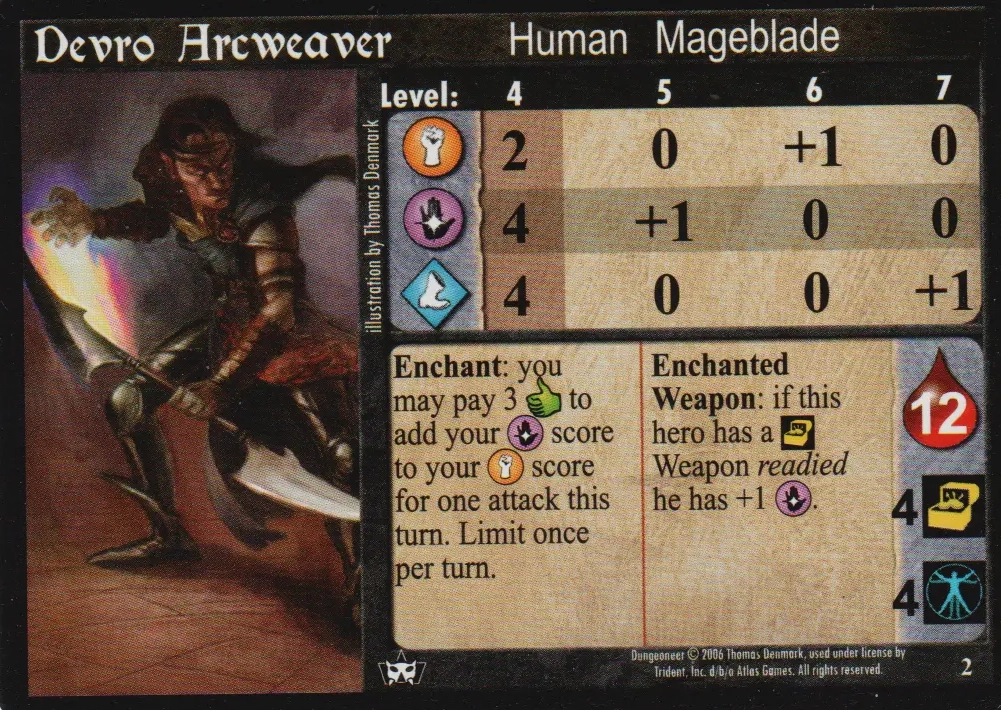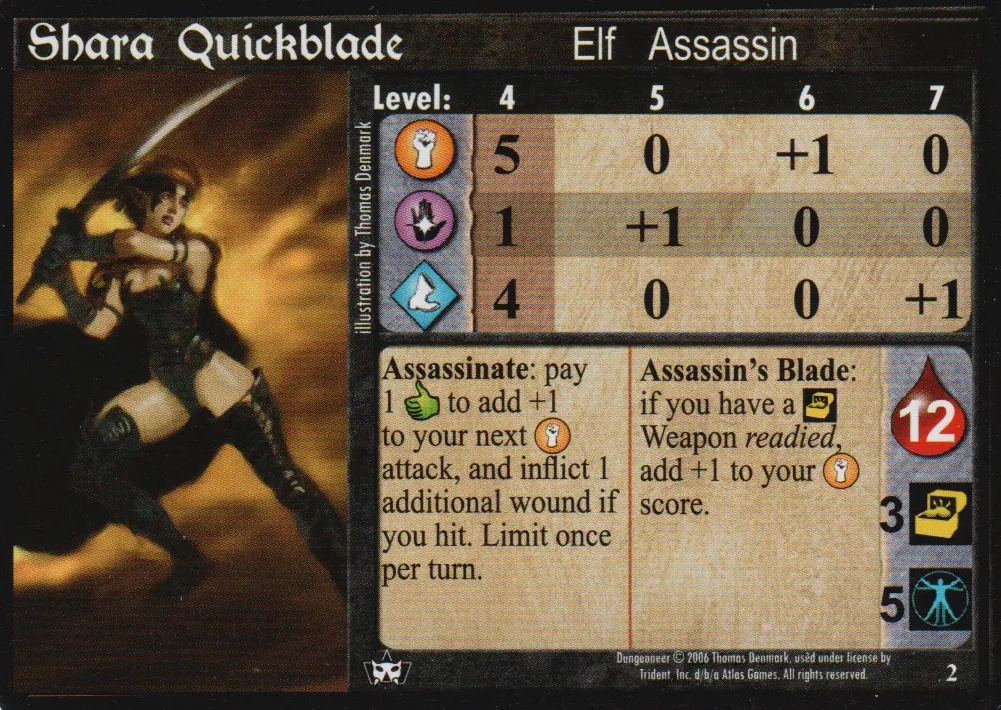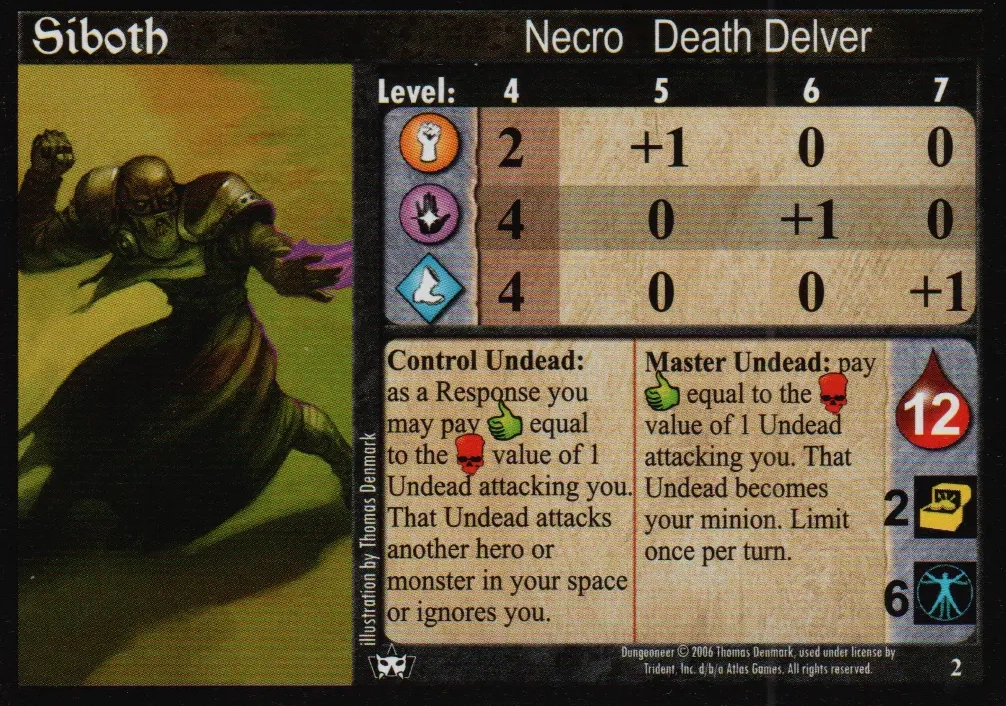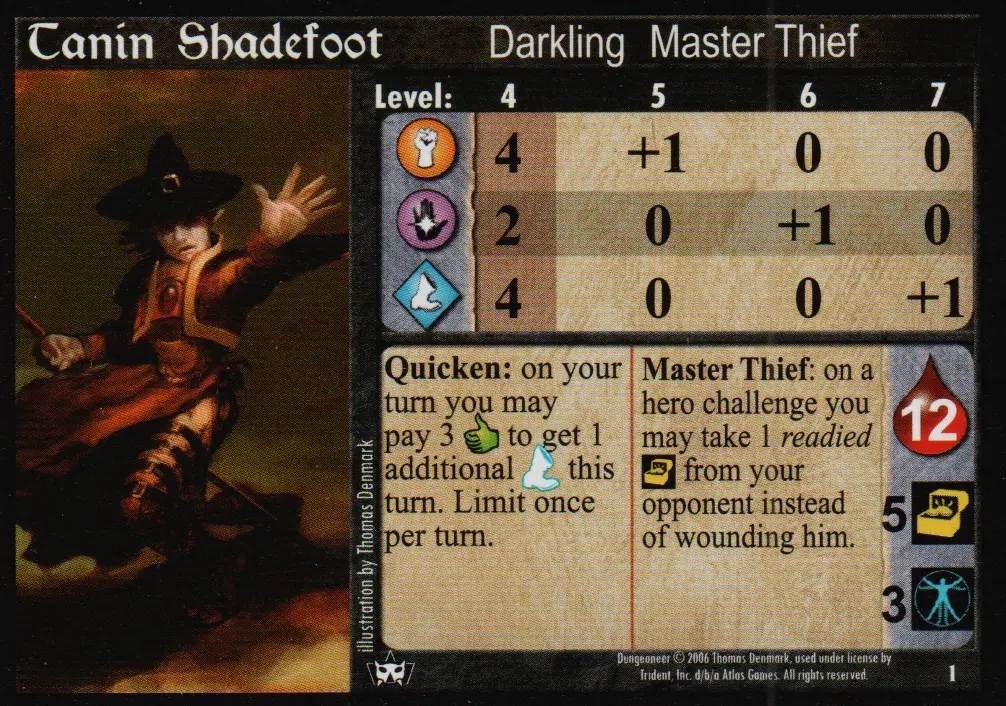I love the game Dungeoneer by Thomas Denmark and published by Atlas Games back in 2005. Dungeoneer is sold as card decks, and I now own them all, so I'm reviewing them each. In this post, I'm looking at the characters of the Call of the Lich Lord set.
For background about the world of Call of the Lich Lord, read my setting of Call of the Lich Lord post.
Non-player characters
There are a few named non-player characters in this set.
Ala Hazad
A notorious master thief, mentioned on Boots of Undead Crushing.
Galik Talus
Probably a historical warrior. The Spectral Sword provides what we know of him:
The spectral sword was a gift of Omnisus to Galik Talus when he sought to defeat Angrihm.
The questions left unanswered by this revelation include:
- Who was Angrihm? There is a map card that depicts the shrine to Angrihm, but it also provides no information on who Angrihm was.
- Why did Angrihm need defeating?
- Does "he" refer to Omnisus ("when Omnisus sought to defeat Angrihm [by sending Galik Talus on a quest]") or Galik ("when Galik sought to defeat Angrihm [and asked Omnisus for aid]")?
- Who is Galik Talus, and is he related to one of this set's heroes, Roderik Talus?
Gvandir
The card Faith and Strength tells us this brief tale:
Though outnumbered, Gvandir drew on his faith and his final strength to prevail against the infernal hordes.
Gvandir was obviously a great warrior and foe of demons, but we know little more of him.
Lich Lord
The Lich Lord is a necromancer who has been made a lich by the goddess Nakari. He is quoted or paraphrased on the Arch Lich Lord card: "I have returned!" At 6 Melee inflicting 3 wounds upon success, and 7 Magic that inflicts 2 wounds and steals 4 Speed, he's a particularly powerful opponent.
The Undead Awakening card says that "The sound of crackling bone and the rotting smell of the Arch Lich Lord's allies permeates the ancient tomb." The Command Undead card says this:
The necromancers of Forlornia have uncovered the forgotten lore of the Eldritch Lords that commands undead.
Either this card is a non sequitur, or the Lich Lord is such a necromancer, and probably from Forlornia.
Mechanically, as long as the Lich Lord is in the game, Undead creatures have a bonus to attack, and each player has easy access to Undead creatures from the discard pile. In other words, the Lich Lord empowers the evil dwelling within his crypt.
Serina
Serina is featured on the Rescue Serina quest, with this flavour text:
Serina went insane upon learning how to control the Throne of Despair.
Serina is likely an adventurer and necromancer, and is NOT the unnamed princess on the Princess in Distress quest card. She must be very powerful, and probably highly ethical. According to her quest card, Serina actually learned how to control the Lich Lord's magical throne, so she's either very good at reverse engineering or she's an accomplished mage. However, she was driven insane by the experience, so she either over-estimated her own resiliency or else her core tenets couldn't withstand the darkness the throne demands.
The heroes are tasked not with capturing, but with rescuing, her. This strongly implies that Serina is considered a fallen hero rather than a threat.
As unrelated as Princess in Distress, the Escort the Colonel card mentions an unnamed officer who was driven insane from studying the Lich Lord's war plans. The term "Escort" is an interesting choice by comparison, and implies that his status may be unknown. Maybe he's a hero, or maybe he's under the influence of the Lich Lord now.
I believe Serina was a previous hero attempting to put a stop to the Lich Lord, and is a trusted but waylaid hero.
Gods
The cosmology of Dungeoneer is artfully (literally, in some cases) developed over each set.
Nakari
Called the Queen of Darkness on the Create Darkness card, Nakari is the goddess of literal darkness at the very least. It is probable that she is the goddess of death and magic mentioned on the back of the Call of the Lich Lord box.
According to the Guardian Manticore card, in the time before the world was created, Nakari defied the will of Omnisus. She created Guardian Manticores to "watch over her children." The card Screeching Harpy identifies Nakari as the "dark mother" of harpies, so presumably they count as her children. But if she is the goddess of magic and death, then her children probably also include the Undead.
The card Blessings of Nakari says:
Nakari, the Queen of Darkness, loves those who love her, and scorns those who do not.
This is maybe uncomfortably similar to the Omnisus' Favour card in Realm of the Ice Witch, which makes it a point to say that Omnisus helps those who serve him. Given that Omnisus and Nakari seem to be opposing forces, this similarity suggests that the gods of Tarnys are not overly benevolent with their powers. They have strict requirements to grant aid, and if you don't qualify then you're on your own.
Nakari's dark powers, interestingly, are at least partially available independent of her blessing. The Spell Refocus card says that "Nakari wove the dark threads of arcane energy, which can only be learned at a price." The actual price, however, is not listed (mechanically, the card grants +2 Magic for 3 Glory.)
Nepiron
The Roll the Bones quest card states that "Fortune depends on the whims of Nepiron, the god of luck." The Ring of Fortune card grants re-rolls, and says "When entering the crypt, you may consider sending a prayer to Nepiron," suggesting that Nepiron is essentially a god you beseech for either an uneventful day or, in a pinch, an outright miracle.
Oriella
Oriella, Queen of Dimensions and ruler of the Ethereal Void, is the goddess of time and relative dimension in space. She's a prolific goddess, too, as the Portable Hole card reveals:
Oriella, the goddess of time and space, has created many strange dimensions that have yet to be discovered.
Omnisus
A major god of Tarnys, with high priests and high priestesses who grant healing to those in need. The Empyreal Blessing card reveals that "only the priestesses can truly bless." But the Potion of Life II card says: "Holy water that is blessed by the high priests of Omnisus restores vitality."
How can high priests bless holy water if only the priestesses can truly bless? This apparent contradiction is easily explained by either taking "high priests" to be inclusive of priestesses, or by believing that a "true" blessing goes beyond the rudimentary blessing of holy water. Both are defensible interpretations, but the latter even has support from the mechanics of the game. Empyreal Blessing cancels a Bane outright, which avoids probable future wounds, while Potion of Life II heals 2 wounds. One cures the disease, while the other only treats symptoms.
Player characters
There are 6 heroes included with the Call of the Lich Lord set, and none of their cards have flavour text.
Devro Arcweaver

A human Mageblade, Devro is likely a barbarian from the north, who invariably use the "-blade" ending to honour their warriors (for example, Frostblade and Warblade in Realm of the Ice Witch). Whether these honourifics are broad or unique, we do not know. It could be that there are whole regiments of Mageblades in the northern armies, or Devro could be the only Mageblade on Tarnys.
We do know, from the card mechanics, the powers of this Mageblade. Devro can pay 3 Glory to add his Magic rating to his Melee attacks. In a sense, he's not actually adept at melee, but he uses magic to make himself effective at melee.
Lorel Alanus

Lorel is an elven Spellslinger. Unsurprisingly, she's got very high Magic, starting at 6 and reaching 7 at Level 3. For just 1 Glory, she can re-roll her Magic combat roll, and she can always re-roll a 1 for free.
She's remarkably bad at Melee (only 1 at Level 5), so she's the classic "squishy wizard" archetype.
Roderik Talus, Human Champion

A human Champion, Roderik is a knight in full plate armour, probably from one of the kingdoms south of Gabrell (which is to say, he's not a barbarian.) He is strong in Melee (starting at Melee 4 at Level 4) and has respectable access to Magic (reaching Magic 3 at Level 6).
Roderik is the classic Paladin archetype. His Healing Hands ability allows him to pay 3 Glory and 1 Move to recover 1 wound, and his Holy Fear ability imposes a -1 attack penalty to all Undead and Demons in his space.
Shara Quickblade, Elf Assassin

Shara Quickblade is one of the few player characters available in more than one set, so you can play her from level 1 all the way up to 7. She first appears in Vault of the Fiends, and her levels continue here, with Magic 1 and Melee 5 at Level 4. Both get a +1 during this game (assuming she lives long enough, of course.)
She's also got a few special abilities. She can pay 1 Glory for +1 Melee (and +1 wound when she hits) once during her turn. If she's gained a special weapon (such as Spectral Sword in this set) and has it readied, then she gets +1 Melee for free.
Siboth, Necro Death Delver

The mysterious Siboth is a Necro Death Delver. There's no explanation of what a Necro is but, because of its position in his card title, I assume it's his ancestry. Maybe he's undead by birth, or maybe he's just a species that's especially attuned to undeath. Whatever he is, he's more powerful with Magic than Melee, and he has the ability to control or master the Undead.
As a response, Siboth can completely offset the Peril of an Undead creature with Glory, causing the Undead creature to ignore him or even to attack another hero or another monster!
Obviously not a bad character to play in this dungeon.
Tanin Shadefoot, Master Thief

Tanin is a Darkling (presumably a halfling, but in the grim dark world of Dungeoneer) Master Thief. He's good at Melee (Melee 4 at Level 4) but also has a little Magic (2 at Level 4.)
His Quicken special ability allows him to pay 3 Glory for +1 Move, once each turn. His Master Thief ability really shakes things up, though. When Tanin challenges another hero and scores a wound, you can steal a readied card from the player character's inventory instead of dealing a wound. Dungeoneer is by no means a co-operative game, but I think this is the most directly aggressive mechanic yet!
Eldritch Lords
The Eldritch Lords were a powerfully magical society of unknown origin or classification. They possibly existed before the world was created, or maybe just as an early society on Tarnys, or even as an alien species that arrived on Tarnys through dimensional portals. They have a great history of magic (they may have literally discovered magic) and there's the sense that their use of magic sometimes angered the gods. Cholizar the Ice Witch was either an Eldritch Lord herself, or was watched and favoured by the Eldritch Lords.
There are several mentions of Eldritch Lords in Call of the Lich Lord.
- Infernal Beast: "The darkest knowledge of the Eldritch Lords is required to summon horrible beasts from the Abyss."
- Gem of Loyalty: "Eldritch Lords prized loyalty above all things, which is why they made this bauble."
- Arcane Force: "The Eldritch Lords first discovered the essence of magic energy. Now this essence is exploited by the Evil Ones."
- Plane Shifted: The card's flavour text says "The Eldritch Lords threatened to end the world with plane shifts on a cataclysmic scale. They failed." This generates many new questions, most importantly whether the Eldlitch Lords explicitly made the threat, or whether their use of plane shifts was an implicit (maybe even accidental, due to their lack of comprehension) threat to Tarnys.
Evil Ones
The Lust for Blood card says:
The smell of innocent blood drives the Evil Ones into an insane rage.
And Arcane Force says "Eldritch Lords first discovered the essence of magic energy. Now this essence is exploited by the Evil Ones."
Because "Evil Ones" is used twice, and both times as capitalised nouns, I assume the term refers to a specific group and not just any evil entity. What we know about the story of Call of the Lich Lord makes me wonder whether "Evil Ones" is a term used to refer to worshippers of Nakari, or maybe to those especially favoured by Nakari (such as the Lich Lord.)
Monsters
There are lots of classic-feeling monsters in Call of the Lich Lord, at least to any veteran dungeon crawler. Some support the necromantic nature of the Lich Lord, while others are alive or infernal monstrous allies.
- Banshee: An malicious undead monster.
- Bone Creeper: Probably the same thing as the "Bone Gnawer" mentioned on the Destroy the Evil Head quest card, a Bone Creeper is an undead abomination that "lies on its bed of bones, waiting..."
- Bug-a-bear: Mentioned, possibly only humourously, in the flavour text of Gilded Key ("Open! Please for the love of Omnisus open! There's a bug-a-bear after me!")
- Carp: Not actually a monster but, according to the Catch the Magic Carp quest card, there are magic fish under the troll bridge.
- Celestial Guardian: A servant of Omnisus, but one that is bound to protect a specific mortal (unlike the celestials of Realm of the Ice Witch, which aid anyone serving Omnisus.)
- Cyclops: There's a cyclops in the Garrison of the dungeon. According to the Slay the Cyclops quest card, "He lurks in his plague-infested lair, gnawing on the bones of fallen heroes."
- Dark Doggy: Despite its forboding title, this is a friendly companion that you sacrifice (or maybe it sacrifices itself) to prevent 1 wound.
- Demon: On the card Infernal Beast, it's revealed that some creatures in the dungeon have been summoned from the Abyss. It's established in Realm of the Ice Witch and Vault of the Fiends that the Abyss is home to demons, so it's safe to take "Infernal Beast" as a reference to a literal demon.
- Greater Ghoul: An undead creature that dines on living flesh. Its flavour text says, "Beware of the ghouls who lust for the marrow in your bones."
- Harpy: The Screeching Harpy card says, "Harpies are cursed by the gods, but were gifted with speed and a deadly voice by Nakari, their dark mother."
- Head: There is the disembodied head of a priest of Lashtar in the Lich Lord's dungeon. It's unclear whether the head is alive or dead or undead, but the Destroy the Evil Head quest says, "Only the Bone Gnawer can destroy the head of Lashtar's evil priest."
- Manticore: "In the darkness before creation, Nakari defied Omnisus and created Guardian Manticores to watch over her children."
- Naga Maiden: The spawn of Knights of Ilbor and priestesses of Nakari.
- Naga Queen: The Naga Queen has allied with the Lich Lord in hopes of strengthening her hold on Northern Ilbor. The Naga Queen might seduce her would-be opponents, as suggested by the combination of the Disarm quest card ("The brave knight was bare naked, except for his helmet, after encountering the Naga Queen") and the Naga Maiden card ("Knights of Ilbor coupled with priestesses of Nakari and spawned Naga Maidens.")
- Shadefang: There are many giant spiders, probably from Balikor, in the dungeon. Shadefang is the giant male spider lurking in the Shrine of Angrihm.
- Spectral Ghost: Untouchable, intangible, but deadly.
- Tenebrous Dragon: "Where death lurks, the shadows coelesce into a Tenebrous Dragon."
- Undead: There aren't cards specific to classic undead creature types, like animated skeletons and ozmbies. However, through artwork on cards like Command Undead and Undead Awakening and Unholy Anger, it's clear that the Lich Lord's crypt is teeming with classic undead corpses.
- Vampire: Undead drinkers of blood, with the ability to turn living people into other vampires: "Many beautiful ladies have disappeared…only to return with an insatiable thirst for blood!"
Lich Lord calling
Call of the Lich Lord honours many tropes of dungeon crawling. There's a magical pair of boots, and a magical ring, and even 51 feet of rope (much better than just 50 feet.) Lots of familiar undead enemies, and some hard-hitting bosses. It's all the more satisfying if you've played its prequel, but it's definitely a fun aspirational dungeon to throw into a Dungeoneer campaign.
Header and card image copyright by Thomas Denmark and Atlas Games, and used exclusively as reference.